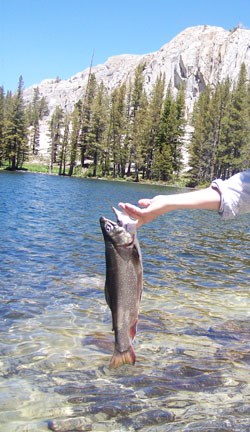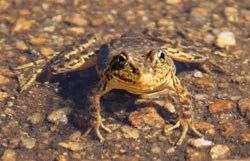
Native fish are only found in the lower elevations of Yosemite. Native fish—including California roach, Sacramento pikeminnow, hardhead, and riffle sculpin—inhabit the lower reaches of the Merced River up to the vicinity of El Portal. Historic accounts suggest that rainbow trout and Sacramento suckers occurred as high as Yosemite Valley on the Merced River. Waterfalls prevented fish from migrating up the Tuolumne River into the Poopenaut and Hetch Hetchy valleys and up the South Fork of the Merced River to Wawona; therefore, the majority of waterbodies in what is now Yosemite were naturally fishless. The recession of glaciers approximately 10,000 years ago left behind thousands of lakes. The glacier-carved landscape and steep topography also resulted in the creation of impassible fish barriers that prevented fish from colonizing most of these waters. As a result, most of the aquatic organisms, such as insects and amphibians, that colonized this fishless landscape evolved for thousands of years in the absence of predatory fish. Non-native fish (primarily trout) have been introduced throughout Yosemite. These non-native predators have a substantial impact on native species and ecosystems. To address impacts, the park began an experimental restoration project in 2007 to remove trout from nine lakes. Today, at least nine non-native fish species exist in Yosemite, including bluegill, smallmouth, five trout species, and two trout hybrids. 
Stocking of Non-native Fish in YosemiteThe history of fish stocking dates back to 1877 when the first recorded fish stocking occurred in the area that became Yosemite National Park. Two years later, the first recorded fish stocking in Yosemite Valley occurred when 20,000 trout were planted into Valley streams. In the early days of fish stocking, fish were transported to water bodies in jugs and coffee cans and later by mule. That eventually gave way to aerial stocking beginning in 1952.
Impacts of Non-native Fish on Aquatic EcosystemsThe impacts of non-native predators on high elevation aquatic and adjacent terrestrial ecosystems are well documented and occur at all levels of the food web. Non-native fish impact native species directly through predation and indirectly through competition for food resources. Non-native fish can disrupt the type and distribution of species, and the natural function of aquatic ecosystems. For example, researchers found that the distribution and abundance of Sierra Nevada yellow-legged frogs, conspicuous aquatic invertebrates (like mayflies) and zooplankton (like daphnia) were dramatically reduced by the introduction of fish. There is no hard boundary between aquatic and terrestrial ecosystems. Leaves, for example, may drop into a lake and provide food for aquatic insect larvae. When insects emerge as adults, they may be eaten by frogs that may in turn be eaten by snakes or birds. When non-native fish consume the insect larvae or frogs, they in turn impact snakes and birds. Consequently, the impacts of non-native fish disrupt the flow of energy and nutrients within and between aquatic and terrestrial ecosystems. 
The Sierra Nevada yellow-legged frog is especially susceptible to the impacts from non-native trout. Trout prey on tadpoles, as well as other life stages and compete with the frog for food. Predation by non-native fish eliminated frogs from larger, deeper lakes and isolated the remaining populations because fish are also present in many streams. This prevents frogs from being able to recolonize lakes where populations have gone extinct, and remaining isolated populations are at much greater risk for extinction. Frogs and fish both require deep lakes because they do not freeze solid in the winter, nor do they dry out in the summer. Lake surveys detected non-native trout in 245 water bodies—these water bodies constitute up to 50% of the larger, deeper lakes. These lakes offer habitat that is crucial for the survival of the Sierra Nevada yellow-legged frog. Frogs were detected in 282 water bodies or 10.6% of the total 2,655 lakes and ponds; only five of these sites contained both fish and frogs.
For fishermen, road access to the lower reaches of the Merced and Tuolumne Wild and Scenic rivers offers excellent opportunities for day trips, while more rugged anglers may prefer to backpack out to one of the many lakes, ponds and streams in Yosemite's Wilderness. Prior to fishing in Yosemite, familiarize yourself with the park's fishing regulations.
More Information
|
Last updated: November 19, 2024
